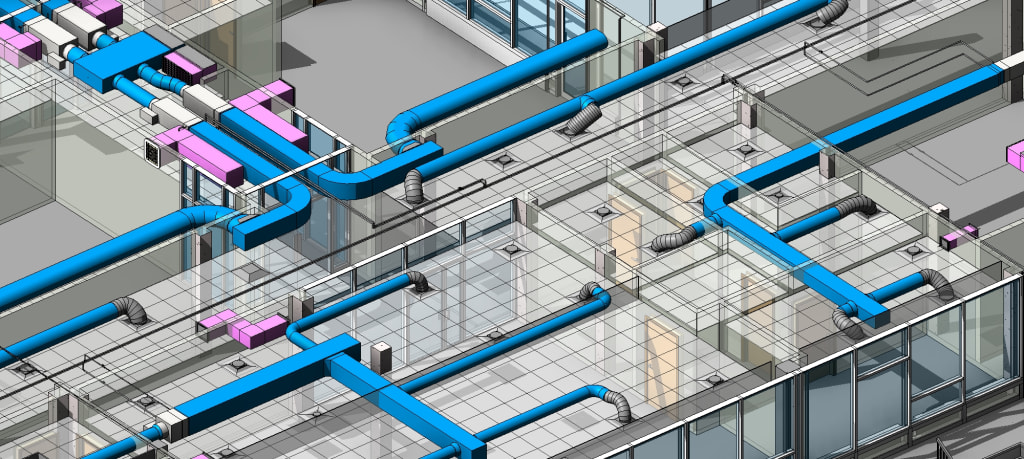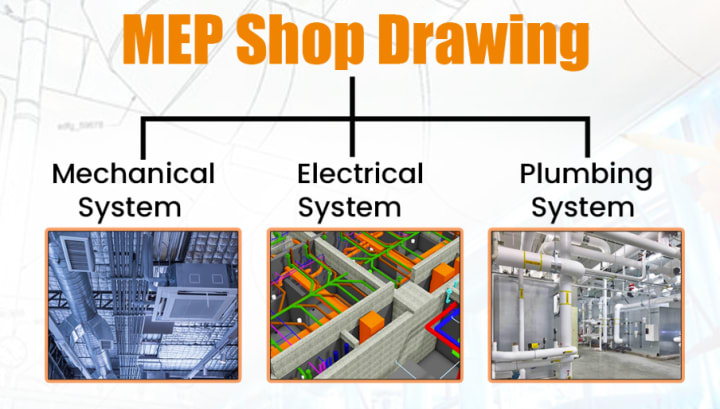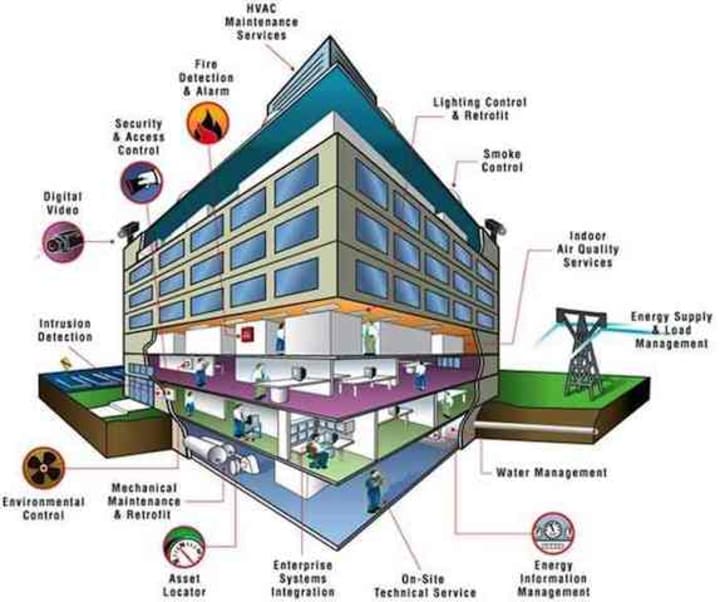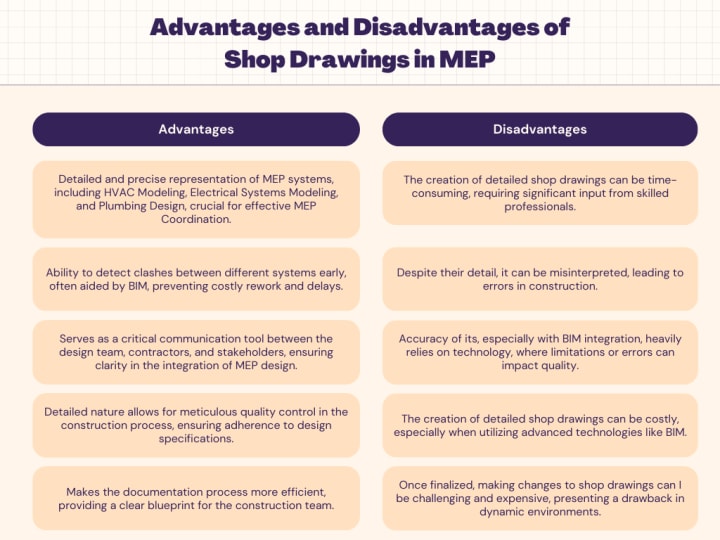How do Shop Drawings contribute to MEP Coordination?
They play a crucial role in MEP coordination by providing a detailed visualization of how different MEP systems interact and fit within the building structure.

Whether it is a construction project or designing the interiors and the exteriors of any building, the designers depend on the MEP (Mechanical, Electrical, and Plumbing) drawings for the smooth installation of the MEP components.
MEP shop drawings are detailed drawings that specifically focus on the mechanical, electrical, and plumbing systems within a building project. They provide a comprehensive representation of these systems, illustrating their layout, dimensions, and specifications.
Constituents of MEP Drawings

Mechanical shop drawings
Mechanical shop drawings mainly deal with the heating, ventilation, and air conditioning (HVAC) systems and determine their placements. The HVAC represents the specifications for installation and fabrication of ducts, customized piping, and the other air-handling units. Besides these, the mechanical shop drawings also represent the transportation systems such as the lifts, escalators, infrastructural, and sometimes, industrial components.
Electrical shop drawings
The electrical systems in a building comprise a power supply and power distribution in building, access, control systems, security systems, information and communication system, interior and exterior lighting as well. Often there arises a conflict between the electrical and mechanical components inside a building. Therefore, with the help of comprehensive electrical shop drawings, contractors can accurately measure the layouts of electrical units to prevent any conflicts that may occur between the electrical and the mechanical components.
Plumbing shop drawings
The plumbing shop drawings represent the plumbing elements within a building which include piping and drainage system, garbage disposals, water carriers, etc. They specify fluid and air transport for heating and cooling, potable and non-potable water supply, and removal of waste.
The MEP challenges faced by building contractors

- Lack of details in design drawings lead to inaccurate component installation
- Lack of project visualization hampers informed decisions
- Absence of detailed information results in inaccurate budget forecasting
- CAD-based drawings or sketches do not allow fabrication standardization
- Low collaboration between stakeholders due to workflow silos
Opening up walls or ceilings to install connections or relocating equipment at a later stage could cause costly rework. MEP shop drawings effectively minimize this by enabling higher first time right MEP installations.
Advantages and Disadvantages of Shop Drawings in MEP

Significance of MEP Shop Drawings
The purpose of Coordinated MEP shop drawings is to communicate the specific requirements and details of the MEP systems to various stakeholders involved in the construction process. These drawings act as a guide for installers, contractors, and subcontractors, helping them understand the precise placement, routing, and installation requirements of mechanical, electrical, and plumbing components.
These detailed drawings provide valuable information and coordination for the mechanical, electrical, and plumbing systems within a structure.
- Coordination and Clash Detection: MEP shop drawings facilitate coordination among various trades involved in the construction process. These drawings illustrate the exact layout, dimensions, and specifications of mechanical, electrical, and plumbing components.
- Accuracy and Precision: They provide precise information about the location of equipment, ductwork, piping, electrical conduits, and other MEP elements. This level of detail ensures that the systems are installed correctly, aligning with architectural and structural components, and adhering to relevant codes and standards.
- Improved Construction Efficiency: The drawings act as a guide, allowing installers to understand the scope of work and plan their tasks accordingly. Accurate shop drawings reduce the need for on-site modifications and improvisations, saving time and resources during the construction process.
- Collaboration and Communication: MEP shop drawings serve as a communication tool among the project stakeholders, including architects, engineers, contractors, subcontractors, and suppliers.
- Compliance and Documentation: Regulatory authorities often require detailed documentation of the mechanical, electrical, and plumbing systems. MEP shop drawings serve as a vital part of this documentation, demonstrating compliance with building codes, regulations, and industry standards.
It's important to note that MEP shop drawings are distinct from design drawings or construction documents produced by MEP engineers. While design drawings focus on the overall system design and calculations, MEP shop drawings provide the detailed information necessary for fabrication, installation, and coordination purposes during the construction phase.
Conclusion
MEP shop drawings are a key component of successful building design and construction. They provide accurate and detailed information about the installation of MEP systems, ensuring that the systems are designed and installed correctly, efficiently, and in compliance with all relevant regulations.
Architects, engineers, and contractors should work closely with experienced MEP shop drawing professionals to ensure the success of their projects.
Frequently Asked Questions
Question: What is the role of BIM in creating MEP shop drawings?
Answer: BIM technology enhances the creation of MEP shop drawings by offering 3D visualization, accurate data management, and facilitating clash detection and energy analysis.
Question: Can shop drawings reduce construction errors?
Answer: Yes, by providing detailed and precise representations of MEP systems, it can significantly reduce construction errors.
Question: Are shop drawings necessary for all construction projects?
Answer: While not mandatory for all projects, they are highly beneficial for complex buildings where precise MEP coordination is essential.
Question: How does the shop drawing process impact project timelines?
Answer: The process of creating that can extend project timelines due to the level of detail and coordination required.
About the Creator
Ryan Stein
I am a renowned author, speaker and educator on Building Information Modeling (BIM) technology in the Architecture, Engineering, and Construction (AEC) industry.






Comments
There are no comments for this story
Be the first to respond and start the conversation.